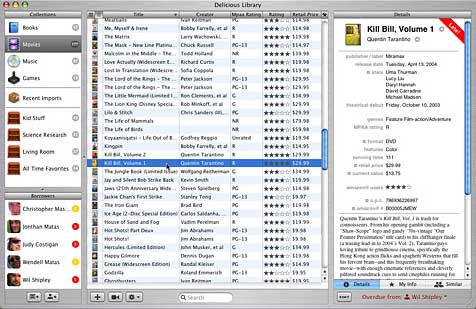I have a collection of hundreds of science fiction novels,
mostly paperbacks. I used to read more B.C. (before children), but
I still manage to squeeze in a novel on an airplane ride now and
then.
Anyway, I've long debated creating a database of the books I own
and adding a sentence or two about each. My favorites are hard
science fiction by authors such as Larry Niven, Robert L. Forward,
and Greg Bear, for example.
Creating a database has always been a snap with an application
like FileMaker; the part I didn't want to get into was the data
entry. Then I discovered Delicious Library by Delicious Monster
Software.
I do pay for the occasional shareware. Usually, though, I use
software for a while before deciding. If I really do use it on a
regular basis, I register. If I don't, well, then, I don't.
I registered Delicious Library the same day I tried it. That's
how good it is.
This OS X-only program uses an iTunes-like interface to organize
your books. Even better, you are spared the burdensome task of data
entry because (I swear I am not making this up) Library uses your
iSight or wireless barcode scanner to scan the barcode on the cover
of your book and nearly instantly look up your book on Amazon's
public book database. It then downloads all the usual information,
such as author, publisher, publication date, and - believe it or
not - a picture of the book's cover, which it places in your
virtual bookshelf.

To use it, you merely hold the barcode in front of the
visual-feeback iSight viewing window, wait for the beep, and you're
done.
It gets better. Not only can it look up most books, it can be
used to organize them as iPhoto and iTunes does, creating
"bookshelves" for your books. You can even check them out to people
in your address book, so it becomes another well-integrated
application in the Mac universe.

Books can be displayed as covers on shelves or in a more
efficient list. Bookshelves can be sorted by a variety of
characteristics such as title and author. The shelves themselves
even gain labels such as "Asimov to Drake," which automatically
change as you add books.
Delicious library does not automatically recognize all books. If
a book is old, it may not be listed on Amazon. If the book's
barcode has been overprinted with some custom vendor's label (such
as happens at Wal-mart), then you may need to scan the bar code on
the book's inside cover.
Delicious Library also tracks music CDs, videos, and games. I
tested this with a couple of samples just to see - it knows these
titles as well.
If Delicious Library cannot recognize your barcode, or the
barcode is missing, you can still type in titles and authors, and
it will present you with a list of titles to match your book. If
you don't own the book, it allows you to order from
Amazon.com, with, I imagine, a small cut going to the
authors, such as happens when your web site is an Amazon
affiliate.
The program is easy to use, useful, and does what it claims. The
help files were useful for those titles the program didn't
automatically recognize. If you keep books in a classroom, like I
do, it is a great tool for checking them out and tracking who has
borrowed what.
It would be nice if it recognized other kinds of barcodes
besides UPC and Amazon barcodes - that way you could print your own
barcode labels and track almost anything. That would be a great
additional feature (especially if it was accompanied by its own
barcode font).
Here at LEM, we often say software is "pricey," but in this case
I think you could easily save $40 by better tracking the books,
games, and videos loaned to friends.
I would say it is a well-made program, and if you need a library
tracking program, well worth the price. It's also fun for a library
geek like myself.
With a little work, such as better integration with Address Book
(it didn't import all the people in my database) and networking
between licensed client databases, a regular library could adopt
this easily as a book tracking program.
I don't normally do stars or little Mac ratings, but here are
some just for the effect: ****. Try this out and enjoy it.
is a longtime Mac user. He was using digital sensors on Apple II computers in the 1980's and has networked computers in his classroom since before the internet existed. In 2006 he was selected at the California Computer Using Educator's teacher of the year. His students have used NASA space probes and regularly participate in piloting new materials for NASA. He is the author of two books and numerous articles and scientific papers. He currently teaches astronomy and physics in California, where he lives with his twin sons, Jony and Ben.< And there's still a Mac G3 in his classroom which finds occasional use.




